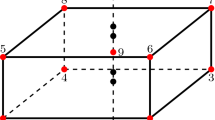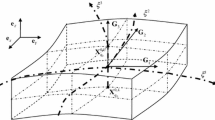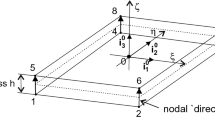Abstract
This paper presents the development of a new prismatic solid-shell finite element, denoted SHB6, obtained using a purely three-dimensional approach. This element has six nodes with displacements as the only degrees of freedom, and only requires two integration points distributed along a preferential direction, designated as the “thickness”. Although geometrically three-dimensional, this element can be conveniently used to model thin structures while taking into account the various phenomena occurring across the thickness. A reduced integration scheme and specific projections of the strains are introduced, based on the assumed-strain method, in order to improve performance and to eliminate most locking effects. It is first shown that the adopted in-plane reduced integration does not generate “hourglass” modes, but the resulting SHB6 element exhibits some shear and thickness-type locking. This is common in linear triangular elements, in which the strain is constant. The paper details the formulation of this element and illustrates its capabilities through a set of various benchmark problems commonly used in the literature. In particular, it is shown that this new element plays a useful role as a complement to the SHB8PS hexahedral element, which enables one to mesh arbitrary geometries. Examples using both SHB6 and SHB8PS elements demonstrate the advantage of mixing these two solid-shell elements.
Similar content being viewed by others
References
S. Ahmad, Analysis of thick and thin shell structures by curved finite elements, Int. J. Numer. Methods Eng., 2 (1970) 419–451.
T. J. R. Hughes and W. K. Liu, Nonlinear finite element analysis of shells: Part I. Three-dimensional shells, Comput. Methods Appl. Mech. Eng., 26 (2001) 331–362.
K. J. Bathe and E. N. Dvorkin, Four-node plate bending element based on Mindlin/Reissner plate theory and a mixed interpolation, Int. J. Numer. Methods Eng., 21 (1985) 367–383.
K. J. Bathe and E. N. Dvorkin, Formulation of general shell elements — The use of mixed interpolation of tensorial components, Int. J. Numer. Methods Eng., 22 (1986) 697–722.
J. C. Simo, D. D. Fox and M. S. Rifai, On a stress resultant geometrically exact shell model. Part III. Computational aspects of the nonlinear theory, Comput. Methods Appl. Mech. Eng., 79 (1990) 21–70.
Y. Cheung and W. J. Chen, Refined hybrid method for plane isoparametric element using an orthogonal approach, Comput. Struct., 42 (1992) 683–694.
E. Onate and J. Castro, Derivation of plate based on assumed shear strain fields, In: P. Ladevèze, O. C. Zienkiewicz, editors, New Advances in Computational Structures Mechanics, Amsterdam: Elsevier (1992) 237–288.
P. Wriggers and F. Gruttmann, Thin shells with finite rotations formulated in Biot stress: theory and finite element formulation, Int. J. Numer. Methods Eng., 36 (1993) 2049–2071.
R. Ayad, G. Dhatt and J. L. Batoz, A new hybrid-mixed variational approach for Reissner-Mindlin plates: The MiSP model, Int. J. Numer. Methods Eng., 42 (1998) 1149–1179.
D. Chapelle and K. J. Bathe, Fundamental considerations for the finite element analysis of shell structures, Comput. Struct., 66 (1998) 19–36.
Q. Zeng and A. Combescure, A new one point quadrature, general non-linear quadrilateral shell element with physical stabilization, Int. J. Numer. Methods Eng., 42 (1998) 1307–1338.
H. Parisch, An investigation of a finite rotation four-node shell element, Int. J. Numer. Methods Eng., 31 (1991) 127–150.
N. Buechter, E. Ramm and D. Roehl, Three-dimensional extension of non-linear shell formulation based on the enhanced assumed strain concept, Int. J. Numer. Methods Eng., 37 (1994) 2551–2568.
P. Betsch, F. Gruttmann and E. Stein, A 4-node finite shell element for the implementation of general hyperelastic 3Delasticity at finite strains, Comput. Methods Appl. Mech. Eng., 130 (1996) 57–79.
M. Bischoff and E. Ramm, Shear deformable shell elements for large strains and rotations, Int. J. Numer. Methods Eng., 40 (1997) 4427–4449.
B. Brank, J. Korelc and A. Ibrahimbegovic, Nonlinear shell problem formulation accounting for through-the-thickness stretching and its finite element implementation, Comput. Struct., 80 (2002) 699–717.
R. P. R. Cardoso and J. W. Yoon, One point quadrature shell element with through-thickness stretch, Comput. Methods Appl. Mech. Eng., 194 (2005) 1161–1199.
W. Graf, T. Y. Chang and A. F. Saleeb, On the numerical performance of three-dimensional thick shell elements using a hybrid/mixed formulation, Finite Elements Anal. Des., 2 (1986) 357–375.
X. Xu and R. Cai, A new plate shell element of 16 nodes and 40 degrees of freedom by relative displacement method, Commun. Numer. Methods Eng., 9 (1993) 15–20.
K. Y. Sze and A. Ghali, Hybrid hexahedral element for solids, plates, shells and beams by selective scaling, Int. J. Numer. Methods Eng., 36 (1993) 1519–1540.
Y. H. Kim and S. W. Lee, A solid element formulation for large deflection analysis of composite shell structures, Comput. Struct., 30 (1993) 269–274.
D. N. Buragohain and P. K. Ravichandran, Modified three-dimensional finite element for general and composite shells, Comput. Struct., 51 (1994) 289–298.
E. Domissy, Formulation et évaluation d’éléments finis volumiques modifiés pour l’analyse linéaire et non linéaire des coques, PhD thesis, UT Compiègne, France (1997).
C. Cho, H. C. Park and S. W. Lee, Stability analysis using a geometrically nonlinear assumed strain solid shell element model, Finite Elements Anal. Des., 29 (1998) 121–135.
R. Hauptmann and K. Schweizerhof, A systematic development of solid-shell element formulations for linear and non-linear analyses employing only displacement degrees of freedom, Int. J. Numer. Methods Eng., 42 (1998) 49–69.
D. Lemosse, Eléments finis isoparamétriques tridimensionnels pour l’étude des structures minces, PhD thesis, INSA-Rouen, France (2000).
K. Y. Sze and L. Q. Yao, A hybrid stress ANS solid-shell element and its generalization for smart structure modeling, Part I-solid-shell element formulation, Int. J. Numer. Methods Eng., 48 (2000) 545–564.
R. Hauptmann, S. Doll, M. Harnau and K. Schweizerhof, Solid-shell elements with linear and quadratic shape functions at large deformations with nearly incompressible mate rials, Comput. Struct., 79 (2001) 1671–1685.
K. Y. Sze and W. K. Chan, A six-node pentagonal assumed natural strain solid-shell element, Finite Elements Anal. Des., 37 (2001) 639–655.
F. Abed-Meraim, A. Combescure, SHB8PS — a new adaptive, assumed-strain continuum mechanics shell element for impact analysis, Comput. Struct., 80 (2002) 791–803.
F. Abed-Meraim, A. Combescure, An improved assumed strain solid-shell element formulation with physical stabilization for geometric non-linear applications and elastic-plastic stability analysis, Int. J. Numer. Methods Eng., 80 (2009) 1640–1686.
A. Legay and A. Combescure, Elastoplastic stability analysis of shells using the physically stabilized finite element SHB8PS, Int. J. Numer. Methods Eng., 57 (2003) 1299–1322.
L. Vu-Quoc and X. G. Tan, Optimal solid shells for nonlinear analyses of multilayer composites, I. Statics, Comput. Methods Appl. Mech. Eng., 192 (2003) 975–1016.
K. Y. Sze, X. H. Liu and S. H. Lo, Hybrid-stress six-node prismatic elements, Int. J. Numer. Methods Eng., 61 (2004) 1451–1470.
Y. I. Chen and G. Y. Wu, A mixed 8-node hexahedral element based on the Hu-Washizu principle and the field extrapolation technique, Struct. Eng. Mech., 17 (2004) 113–140.
K. D. Kim, G. Z. Liu and S. C. Han, A resultant 8-node solid-shell element for geometrically nonlinear analysis, Comput. Mech., 35 (2005) 315–331.
R. J. Alves de Sousa, R. P. R. Cardoso, R. A. Fontes Valente, J. W. Yoon, J. J. Gracio and R. M. Natal Jorge, A new one-point quadrature enhanced assumed strain (EAS) solid-shell element with multiple integration points along thickness: Part I — Geometrically linear applications, Int. J. Numer. Methods Eng., 62 (2005) 952–977.
R. J. Alves de Sousa, R. P. R. Cardoso, R. A. Fontes Valente, J. W. Yoon, J. J. Gracio and R. M. Natal Jorge, A new one-point quadrature enhanced assumed strain (EAS) solid-shell element with multiple integration points along thickness: Part II — Nonlinear applications, Int. J. Numer. Methods Eng., 67 (2006) 160–188.
R. J. Alves de Sousa, J. W. Yoon, R. P. R. Cardoso, R. A. Fontes Valente and J. J. Gracio, On the use of a reduced enhanced solid-shell (RESS) element for sheet forming simulations, Int. J. Plasticity, 23 (2007) 490–515.
S. Reese, A large deformation solid-shell concept based on reduced integration with hourglass stabilization, Int. J. Numer. Methods Eng., 69 (2007) 1671–1716.
J. C. Simo and M. S. Rifai, A class of mixed assumed strain methods and the method of incompatible modes, Int. J. Numer. Methods Eng., 29 (1990) 1595–1638.
J. C. Simo and F. Armero, Geometrically non-linear enhanced strain mixed methods and the method of incompatible modes, Int. J. Numer. Methods Eng., 33 (1992) 1413–1449.
J. C. Simo, F. Armero and R. L. Taylor, Improved versions of assumed enhanced strain tri-linear elements for 3D finite deformation problems, Comput. Methods Appl. Mech. Eng., 110 (1993) 359–386.
E. N. Dvorkin and K. J. Bathe, Continuum mechanics based four-node shell element for general non-linear analysis, Eng. Comput., 1 (1984) 77–88.
T. Belytschko and L. P. Bindeman, Assumed strain stabilization of the eight node hexahedral element, Comput. Methods Appl. Mech. Eng., 105 (1993) 225–260.
Y. Y. Zhu and S. Cescotto, Unified and mixed formulation of the 8-node hexahedral elements by assumed strain method, Comput. Methods Appl. Mech. Eng., 129 (1996) 177–209.
P. Wriggers and S. Reese, A note on enhanced strain methods for large deformations, Comput. Methods Appl. Mech. Eng., 135 (1996) 201–209.
S. Klinkel and W. Wagner, A geometrical non-linear brick element based on the EAS-method, Int. J. Numer. Methods Eng., 40 (1997) 4529–4545.
S. Klinkel, F. Gruttmann and W. Wagner, A continuum based three-dimensional shell element for laminated structures, Comput. Struct., 71 (1999) 43–62.
W. A. Wall, M. Bischoff and E. Ramm, A deformation dependent stabilization technique, exemplified by EAS elements at large strains, Comput. Methods Appl. Mech. Eng., 188 (2000) 859–871.
S. Reese, P. Wriggers and B. D. Reddy, A new locking-free brick element technique for large deformation problems in elasticity, Comput. Struct., 75 (2000) 291–304.
M. A. Puso, A highly efficient enhanced assumed strain physically stabilized hexahedral element, Int. J. Numer. Methods Eng., 49 (2000) 1029–1064.
O. C. Zienkiewicz, R. L. Taylor and J. M. Too, Reduced integration technique in general analysis of plates and shells, Int. J. Numer. Methods Eng., 3 (1971) 275–290.
S. Pawsey and R. Clough, Improved numerical integration of thick shell finite elements, Int. J. Numer. Methods Eng., 3 (1971) 575–586.
T. J. R. Hughes, R. L. Taylor and W. Kanoknukulchai, A simple and efficient finite element for plate bending, Int. J. Numer. Methods Eng., 11 (1977) 1529–1543.
D. P. Flanagan and T. Belytschko, A uniform strain hexahedron and quadrilateral with orthogonal hourglass control, Int. J. Numer. Methods Eng., 17 (1981) 679–706.
J. O. Hallquist, Theoretical manual for DYNA3D, Report UC1D-19401, Lawrence Livermore National Laboratory, Livermore, CA, USA (1983).
J. Fish and T. Belytschko, Elements with embedded localization zones for large deformation problems, Comput. Struct., 30 (1988) 247–256.
J. C. Simo and T. J. R. Hughes, On the variational foundations of assumed strain methods, ASME J. Appl. Mech., 53 (1986) 51–54.
R. H. MacNeal and R. L. Harder, A proposed standard set of problems to test finite element accuracy, Finite Elements Anal. Des., 1 (1985) 3–20.
J. L. Batoz and G. Dhatt, Modelling of structures by finite elements, Paris: Hermès Science (1992).
T. Belytschko, B. L. Wong and H. Stolarski, Assumed strain stabilization procedure for the 9-node Lagrange shell element, Int. J. Numer. Methods Eng., 28 (1989) 385–414.
A. Legay, Une méthode de calcul efficace pour l’étude paramétrique du flambage non-linéaire de structures tridimensionnelles: application à la fiabilité. PhD thesis, LMT-ENS-Cachan, France (2002).
J. M. Bourinet, N. Gayton and M. Lemaire, A. Combescure, Reliability analysis of stability of shells based on combined finite element and response surface methods, In: M. Papadrakis, A. Samartin, E. Onate, editors. Computational Methods for Shell and Spatial Structures, IASS-IACM, Athens, Greece (2000).
I. Leahu-Aluas and F. Abed-Meraim, A proposed set of popular limit-point buckling benchmark problems, Struct. Eng. Mech., 38 (2011) 767–802.
M. Killpack and F. Abed-Meraim, Limit-point buckling analyses using solid, shell and solid-shell elements, J. Mech. Sci. Tech., 25 (2011) 1105–1117.
Author information
Authors and Affiliations
Corresponding author
Additional information
This paper was recommended for publication in revised form by Editor Maenghyo Cho
Vuong-Dieu Trinh graduated as a Civil Engineer from the National Civil Engineering School, Ha Noi, Vietnam in 2001. He received his M.S. in Structural Mechanics from École Nationale des Ponts et Chaussées, Paris in 2003 and his Ph.D in Structural and Applied Mechanics from Arts et Métiers ParisTech, Metz Campus in 2008. He is currently working as a Civil Engineer at Peikko Group Corporation, an international company.
Farid Abed-Meraim received his Ph.D in Theoretical and Applied Mechanics from École Polytechnique, Paris in 1999. He joined Arts et Métiers ParisTech, Metz Campus in 2000, where he is currently an Associate Professor at the LEM3 laboratory. His main research interests include structural stability (bifurcation) analysis of dissipative systems (elasto-plastic, visco-elastic and visco-plastic), material instability modeling in relation to the prediction of formability of metal sheets, as well as finite element technology (solid-shell formulations).
Alain Combescure graduated from École Polytechnique, Paris in 1973. After 20 years at the French Atomic Commission as a research engineer and team leader, working on the simulation of buckling under complex loads, he joined the LMT laboratory at ENS Cachan, where he has been working for six years as a Professor in the field of transient non-linear Mechanics. He was then appointed Professor at INSA Lyon and head of the LaMCoS laboratory. His main research interests concern fracture mechanics, phase transformation in metals, time space subdomain coupling, and X-FEM methods for transient crack propagation.
Rights and permissions
About this article
Cite this article
Trinh, VD., Abed-Meraim, F. & Combescure, A. A new assumed strain solid-shell formulation “SHB6” for the six-node prismatic finite element. J Mech Sci Technol 25, 2345–2364 (2011). https://doi.org/10.1007/s12206-011-0710-7
Received:
Revised:
Accepted:
Published:
Issue Date:
DOI: https://doi.org/10.1007/s12206-011-0710-7




